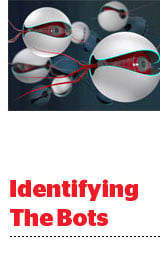 It’s been six months since botnets entered the advertising lexicon in a big way, thanks to research and publicity efforts by self-styled fraud fighters and firms that specialize in detecting nonhuman traffic. March stories in Adweek, AdExchanger and other publications shined a spotlight on the pervasiveness of nonhuman Internet traffic and its threat to the value proposition of digital ads.
It’s been six months since botnets entered the advertising lexicon in a big way, thanks to research and publicity efforts by self-styled fraud fighters and firms that specialize in detecting nonhuman traffic. March stories in Adweek, AdExchanger and other publications shined a spotlight on the pervasiveness of nonhuman Internet traffic and its threat to the value proposition of digital ads.
All the attention sent the bots scurrying to dark corners, starved out by agencies and ad networks newly alert to the menace. Oh wait, no it didn’t.
Truth is, the bots are still out there – in part because the incremental fees they generate for exchange players are just too sweet to pass up. That means, discouragingly, that plenty of demand still flows to “phantom publishers” such as Alphabird and the impressions they sell – as well as some otherwise legit publishers that benefit from botnet traffic.
Media6degrees says the ratio of nonhuman traffic (NHT) it sees on exchanges has not changed since the issue bubbled up in the press. The company has observed many clones of websites in the Alphabird network (Alphabird, along with DigiMogul, received the lion’s share of attention as a hotbed of NHT). In one weeklong period earlier this month, m6d blocked 700 new publications that had audience overlap of between 50% and 100% with at least five other publications – suggesting NHT traffic of a sort observed earlier this year in the Chameleon botnet, responsible for upwards of 9 billion monthly impressions on sites run by Alphabird, DigiMogul and others.
Today M6d tracks suspicious traffic on 18 platforms, and breaks down their NHT traffic this way:
- 0-10% suspicious – five platforms (including pure FBX, pure Yahoo and “almost pure” YouTube)
- 10-20% suspicious – five platforms
- 20-30% suspicious – three platforms
- 30-40% suspicious – three platforms
- 40-50 % suspicious – two platforms
But…Why?
“The percentage of suspicious traffic that we see has not dropped at all, from most supply-side partners, and we believe it’s due to the addiction,” said Alec Greenberg, m6d’s VP of media operations. “From top to bottom in the advertising chain it continues to make everyone (and their performance) look good.”
AppNexus has been engaged in an ongoing game of cat and mouse with botnet traffic, which can be surprisingly hard to detect, according to CEO Brian O’Kelley. As Spider.io noted in its report on the Alphabird publisher network last year, the methods used to emulate human impressions include generating rollovers and click-through rates at levels consistent with the general population.
O’Kelley says AppNexus continues to encounter large botnet players, suggesting the NHT problem may require a drawn-out fight — one waged more by ad ops teams than by journalists.
“I think this is a classic follow-the-money situation,” he said. “We’re seeing a lot of shifts in botnets as detection methods improve. We shut a big one down over the weekend, but seems like they’ll keep coming back until the economics disappear.”
But, even as many exchanges and SSPs drag their feet, a growing number of buy-side players are focused on the problem. Fraud detection has become a bigger business, with companies such as Spider.io, whiteops and Telemetry pitching their ability to identify fraudulent traffic.
Matt Greitzer, chief operating officer at Accordant Media, has engaged one such firm to aid NHT detection.
“In general, there are some serious problems out there and if you aren’t diligent you can be very exposed,” Greitzer said.
The problem isn’t likely to diminish this year. Removing NHT from the exchanges will create a corresponding decline in revenue and ad performance during the crucial holiday season – that in turn will alarm ad buyers and network partners.
“Now that we’re closing in on Q4,” said M6d’s Greenberg, “I don’t see anything drastic happening this year.”














